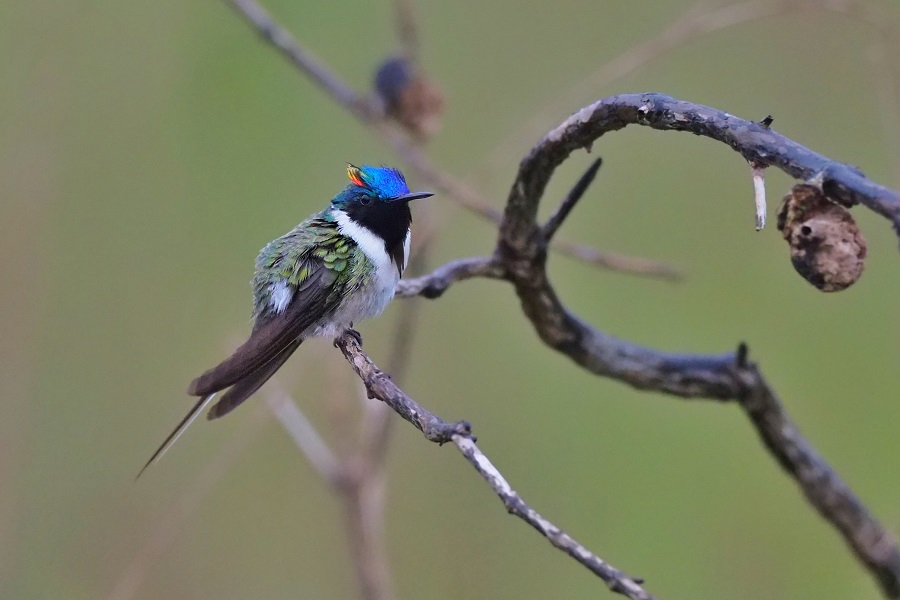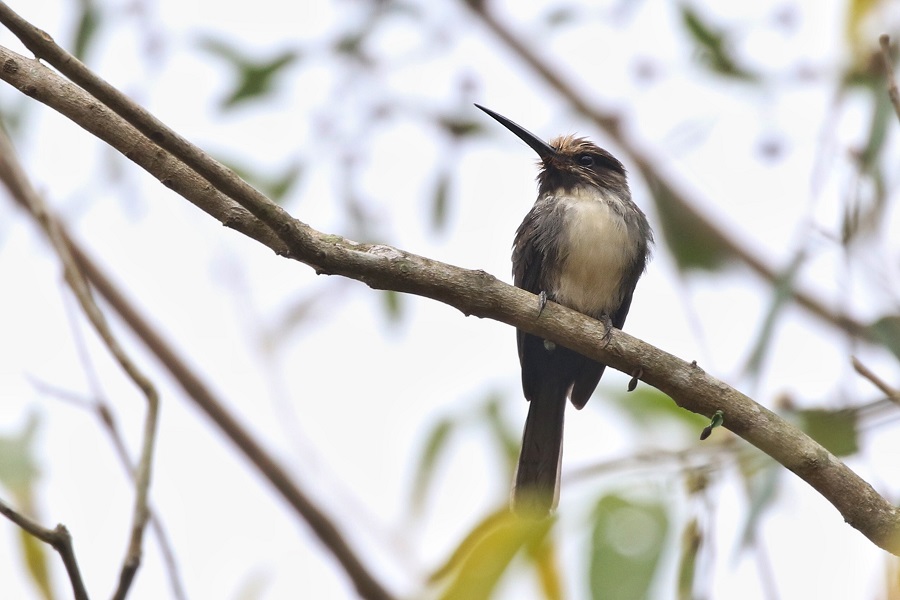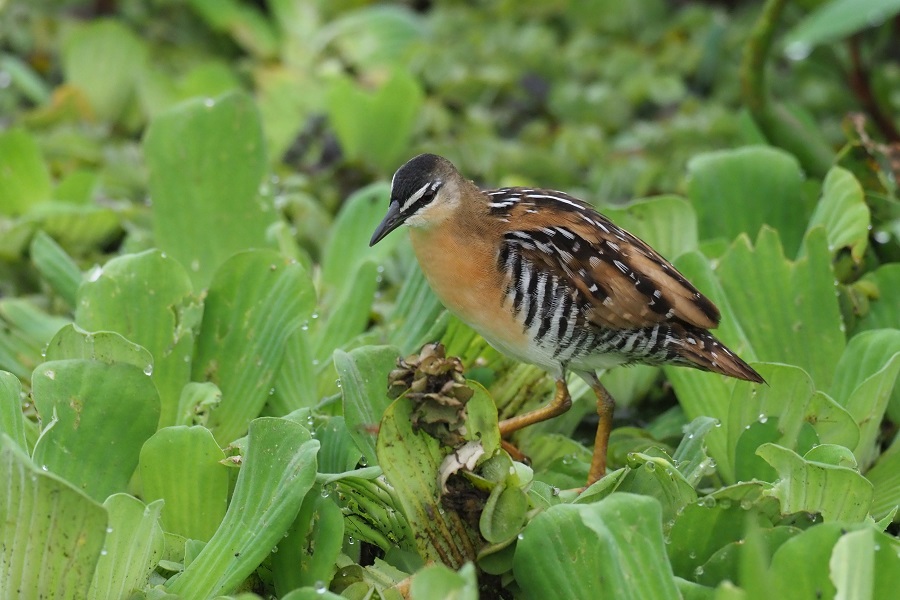Brazil: North-East
This special tour visits the endemic Caatinga biome, together with the best remnant sites of rich Atlantic Forest, plus bit of Cerrado and Campo Rupestre from the Tepui-like Chapada Diamantina. Offering a chance for 100+ endemics (more than any other region in Brazil) from what is certainly one of the most threatened avifaunas in the world, this incredible tour targets many superb species such as Lear’s Macaw, Giant Snipe, Araripe Manakin, Hooded Visorbearer, Great Xenops, Slender Antbird, Fringe-backed Fire-eye, Banded Cotinga, and more.
Next Dates
27 January - 15 February 2026 (20 days)
Leaders:
Eduardo Patrial
Group Size Limit:
6
Single Room Supplement: $
600 USD
Deposit: $
750 USD
Price: $
7400 USD
Add a Title
Leaders:
Eduardo Patrial
Group Size Limit:
Add a Title
Single Room Supplement: $
TBD
Deposit: $
TBD
Price: $
TBD
Add a Title
27 January - 15 February 2027 (20 days)
Leaders:
Eduardo Patrial
Group Size Limit:
6
Single Room Supplement: $
700 USD
Deposit: $
750 USD
Price: $
7800 USD
Add a Title
Leaders:
Eduardo Patrial
Group Size Limit:
Add a Title
Single Room Supplement: $
TBD
Deposit: $
TBD
Price: $
TBD
Add a Title
Accommodation:
Comfortable hotels throughout.
Walking difficulty:
Mostly easy roadside birding with short forays onto forest trails. One moderate hike for Boa Nova Tapaculo.
Tour cost includes:
All accommodation, main meals, drinking water, internal flights (as stated in itinerary), overland transport, tips to local drivers and guides, travel permits, entrance fees, and guide fees.
Tour cost excludes:
Flights before and after the tour start/end, visa, travel insurance, tips to tour leaders, laundry, drinks, and other items of a personal nature.


Day 1: Arrivals into Fortaleza International Airport (FOR) in the northern state of Ceará. A quick introduction in Fortaleza for the appealing Jandaya Parakeet before the transfer to Sobral. Early evening check-in, dinner and overnight.
Day 2: Early morning in Sobral, we will be visiting lowland Caatinga (Carnaubal forest habitat), mainly in search of the rare endemic Moustached Woodcreeper. Other likely birds include Caatinga Parakeet, Caatinga Puffbird, Caatinga Cacholote, Pale Baywing, Ochraceous Piculet, Ochre-backed Woodpecker, Campo Troupial, White-naped Jay, Red-cowled Cardinal and Scarlet-throated Tanager. Then for the rest of the day, we will be exploring the interesting hills of Serra da Meruoca, where deciduous forest on foothills turns into tropical forest at higher elevations, one of the major habitats in Ceará state to find this exclusive northern Brazil specialty. Here we will also attempt the endemics Ceara Woodcreeper, Planalto Slaty Antshrike and Grey-headed Spinetail. Additional species might include Masked Duck, Planalto Hermit, Ochre-cheeked Spinetail, Black-capped Antwren, Orange-headed Tanager and Pectoral Sparrow. The scarce Buff-fronted Owl occurs in Meruoca, and we can try for it at a few known sites in the evening, although it has become much less reliable here in recent years. Night in Sobral.
Day 3: Early morning at an impressive little corner in Sobral, simply THE place for crakes, with Yellow-breasted, Grey-breasted and Rufous-sided Crakes, and Spotted Rail and Least Bittern on the menu too. Then, we will drive east to Guaramiranga, on the hills of Serra do Baturité. The hills guard humid forest such as an isolated Atlantic Forest remnant in the Caatinga region, home of several endemics that we’ll be looking for: the very-restricted, Grey-breasted Parakeet; Ceara Leaftosser, Ceara Gnateater, Ceará Woodcreeper, Grey-headed Spinetail and Buff-breasted Tody-Tyrant. Several other cool birds are available in this area, like Gould’s Toucanet, Yellow-chevroned Parakeet, Ochre-backed Woodpecker, Red-billed Scythebill, cearensis Variable Antshrike, Planalto and Guianan Tyrannulets, Band-tailed Manakin and the stunning, Red-necked Tanager. With luck in Guaramiranga, we can even find the rare, Yellow-faced Siskin. Night in Guaramiranga.
Day 4: Following some morning birding in the area, we’ll drive to the nice Hotel Pedra dos Ventos (near Quixadá), which usually welcomes birders with amazing views of endemic Pygmy Nightjars roosting right by their porch! White-naped Jay is common here, while other targets include Black-bellied Antwren, Long-billed Wren and more chances for Ochre-backed Woodpecker and the erratic Scarlet-throated Tanager. By the end of the day, we will hope to have seen the endemic White-browed Guan in the area and maybe come across White-bellied Nothura or Small-billed Tinamou. Night at Pedra dos Ventos.
Day 5: Transferring early to Crato, we will arrive at the famous Arajara Park in good time to enjoy the fascinating and Critically Endangered endemic Araripe Manakin, one of the most wanted birds of the tour. We may also see “Tawny” Ochraceous Piculet here before moving to the edge of Araripe National Forest in search of the endemics White-browed Antpitta, Great Xenops, Silvery-cheeked Antshrike and Caatinga Antwren. Others from Araripe National Forest area include Barred (Caatinga) Antshrike, Stripe-backed Antbird, Pale-bellied Tyrant-Manakin and the endemic Cinnamon Tanager. Night in Crato.
Day 6: More of carrasco Caatinga habitat around Araripe National Forest in the morning should guarantee such beauties as Great Xenops and White-browed Antpitta. Late morning transfer to the lovely lodge Sítio Pau Preto in Potengi, where in the afternoon we can look for more Caatinga specialties such as Broad-tipped Hermit, Great Xenops (if necessary), Red-shouldered Spinetail, Stripe-backed Antbird, Ash-throated Casiornis, Bahian and Greater Wagtail Tyrants, White-naped Xenopsaris, Grey-eyed Greenlet and White-throated Seedeater. Dusk at Pau Preto usually comes with several Least Nighthawks flying around at close range! Night in Potengi.
Day 7: We leave Ceará state with an early departure to Canudos, in northern Bahia, part of a vast arid region covered by the typical thorny Caatinga vegetation. Approaching Canudos, we have a stop at a Blue-winged Macaw nesting site near Bendegó, where we should also find Suiriri and Southern Scrub Flycatchers. After lunch and check-in, we will bird the typical Caatinga along the entrance road of Canudos Biological Station, an area particularly good to look for the stunning Ruby-topaz Hummingbird, endemics Stripe-breasted Starthroat, Broad-tipped Hermit and Red-shouldered Spinetail; and Blue-crowned Parakeet. Others in the habitat include Swallow-tailed Hummingbird, Glittering-bellied Emerald, Dark-billed Cuckoo, Caatinga Puffbird, Caatinga Parakeet, Bahian Wagtail Tyrant, Black-throated Saltator and chances of Spotted Piculet. Least Nighthawks should come out at dusk, and we can also try for Little and Scissor-tailed Nightjars. Night in Canudos.
Day 8: The long-awaited early morning for the Lear’s Macaw spectacle at Canudos Biological Station: the wake up of dozens of macaws at their roosting and nesting cliffs. Seeing this spectacular Critically Endangered species at close range as the dawn light hits the red cliffs is for sure one of the best birding experiences of the tour, and indeed the world! Later that morning we start moving southeast towards the coast of Bahia, having a brief stop in the Caatinga for the endemic Pectoral Antwren. Our destination is the Atlantic Forest from Aruá next to Praia do Forte, home of Fringe-backed Fire-eye, another threatened endemic that we shall have a go by late afternoon. Night at Aruá.
Day 9: Early morning shall guarantee our chances with Fringe-backed Fire-eye and give us time to try the rare Pernambuco Foliage-gleaner and more endemics such as Bahia Antwren, Scaled Antbird, Sooretama Slaty Antshrike, Black-cheeked Gnateater and Kinglet Manakin. Others possible here include Reddish Hermit, Black-necked Aracari, Red-headed and Blue-backed Manakins, Trilling Gnatwren and maybe the large Maned Three-toed Sloth. Later in the morning we depart for the quite long drive to the lovely Lençois, in Chapada Diamantina, for a two-night stay.
Day 10: Full day of birding in the stunning landscape of Chapada Diamantina! The main star here certainly is the fantastic endemic Hooded Visorbearer, while the fascinating campo rupestre habitat holds other endemics and a great selection of birds, to include Spotted Piculet, the localised Sincora Antwren; Rufous-winged Antshrike, Spix’s Spinetail, Collared Crescentchest, Plain-crested and Small-headed Elaenias, Serra Finch, Ultramarine Grosbeak, Cinnnamon and Gilt-edged Tanagers, and Yellow-bellied and White-bellied Seedeaters. The afternoon in some nearby forest will hopefully yield the stunning Helmeted Manakin, plus aurantius Surucua Trogon, White-shouldered Fire-eye, Grey-headed Elaenia, and Sibilant Sirystes. Our guesthouse in Lençois will offer a few hummers at the feeders, like Planalto Hermit and Glittering-throated Emerald. Night in Lençois.
Day 11: Transfer to Mucugê in the southern Chapada Diamantina, with lots of birding stops along the way! Early on, the first stops in Caatinga should provide the uncommon endemic Sao Francisco Sparrow and the noisy East Brazilian Chachalaca. Later, the spectacular Chapada scenery will put us in contact with the biome Cerrado where we will be looking for many specialties from this rich savanna habitat, to mention the mind-blowing Horned Sungem; White-vented Violetear, Red-legged Seriema, White-eared Puffbird, Rusty-backed Antwren, Collared Crescentchest, Rufous-sided Scrub Tyrant, Blue Finch, Stripe-tailed Yellow Finch, Shrike-like and White-rumped Tanagers, Black-throated Saltator and Copper Seedeater. Reaching Mucugê, we will have time in the afternoon to cover more of the breath-taking campo rupestre habitat to try for the endemics Diamantina Tapaculo and Grey-backed Tachuri, more of Hooded Visorbearer (if necessary) and the uncommon Brown Violetear which has in Chapada an isolated disjunct population. Night in Mucugê.
Day 12: Early morning around Mucugê to look for the locally rare Sharp-tailed Grass Tyrant in scrubby Cerrado, and to visit a peculiar Caatinga woodland (mata de cipó) mainly in search of the endemic Narrow-billed Antwren, a site that offers more chances for beauties like Ochre-backed Woodpecker, Great Xenops, Ceara Gnateater, Caatinga Antwren, Ash-throated Casiornis and Hangnest Tody-Tyrant. After a delicious breakfast at our guesthouse, we will then take the quite long drive to Boa Nova, having an interesting stop in deciduous forest near Iramaia to look for the rare Brazilian endemic Minas Gerais Tyrannulet. Back to road, we hope to get to Boa Nova by the end of the day and have an after-dusk attempt for Tawny-browed Owl. Night in Boa Nova.
Day 13: In this full day in Boa Nova, the morning shall be a blast in the rich Atlantic Forest from Mata do Charme. Besides the restricted and uncommon main targets - Striated Softtail, Bahia Spinetail and Rio de Janeiro Antbird – we expect to find several other Brazilian endemics and an amazing new array of birds, which includes Crescent-chested Puffbird, Spot-billed Toucanet, Black-necked Aracari, East Brazilian Pygmy Owl, Yellow-throated Woodpecker, Golden-spangled Piculet, Maroon-bellied and Golden-capped Parakeets, White-collared, White-eyed and Ochre-breasted Foliage-gleaners, Pallid Spinetail, Black-billed Scythebill, Tufted Antshrike, Ferruginous Antbird, Spot-breasted Antvireo, White-shouldered Fire-eye, Rufous Gnateater, Fork-tailed Tody-Tyrant, Oustalet’s Tyrannulet, Cinnamon-vented Piha, Pin-tailed Manakin, Sharpbill, Yellow-green Grosbeak, Sooty Grassquit and many other possibilities. In the afternoon we will visit mata de cipó habitat for the smart and localised Slender Antbird, together with the impressive rocky outcrop spot known as Lajedo, dominated by Melocactus and stunning orchids, an enchanting habitat that often provides excellent encounters with Ruby-topaz Hummingbird, Sapphire-spangled Emerald, Swallow-tailed Hummingbird, and Stripe-breasted Starthroat. At dusk, we will hopefully be able to find the impressive Giant Snipe! Night in Boa Nova.
Day 14: Early transfer and birding in the neighbouring town of Poções. We will spend the morning at the impressive Serra do Arrepio. The transitional Caatinga to Atlantic Forest in this place is just incredible and will get us busy after rarities such as Wied’s Tyrant Manakin, Hook-billed Hermit and Reiser’s Tyrannulet. There we also hope to find Scaled Woodcreeper, White-bibbed Antbird, Rufous-capped Antthrush, Buff-throated Purpletuft, Southern Antpipit, Hangnest Tody-Tyrant, Grey-capped Tyrannulet, Greenish Schiffornis, Blue Manakin, and if necessary, more from mata de cipó (Narrow-billed Antwren and Slender Antbird). In the afternoon we should visit other Atlantic Forest remnants in search of the endemics Three-toed Jacamar, Orange-eyed Thornbird, Bahia Tyrannulet and the undescribed ‘Bahia’ Treehunter Heliobletus. Poções should offer more opportunities for Giant Snipe and Tawny-browed Owl. Night in Poções.
Day 15: For the remainder of the tour we will be covering Atlantic Forest habitats in southern Bahia. An early transfer down the hills will put us to visit a forest fragment near Itororó, mainly to look for the threatened endemic Scalloped Antbird. Here we also expect to find Southern White-fringed Antwren and to have more chances for Hook-billed Hermit, Black-cheeked Gnateater and Sooretama Slaty Antshrike. After a nice lunch nearby with delicious green coconut juice, we will drive to Camacã, making stops to look for the tricky endemic Pink-legged Graveteiro, which has a taste for nesting by the busy highway BR 101. If time allows in the afternoon, we will visit one of the lowland forests from Serra Bonita, the Fazenda Paris, where we can search for the Critically Endangered and impressive Banded Cotinga, together with few other endemics such as White-eared, Ochre-marked and Golden-capped Parakeets, and White-bellied and Opal-rumped (Silver-breasted) Tanagers. Night in Camacã.
Day 16: Day trip to visit the hills of Serra das Lontras National Park. Here the higher elevation is one of the last remaining sites to find this rare and localised Boa Nova Tapaculo, our main target species. The hike uphill offers good birding and a fine list of important endemics in the region, like Mantled Hawk, Buff-bellied Puffbird, the shy Black-headed Berryeater; Cinnamon-vented Piha, White-winged Cotinga, Pale-browed Treehunter, the undescribed Heliobletus ‘Bahia’ Treehunter; Bahia Tyrannulet and more. Back to Camacã in the afternoon, we will transfer up to the Serra Bonita Lodge.
Day 17: Full day of birding uphill at Serra Bonita Lodge. Main attempts are to include the rare Plumbeous Antvireo and Salvadori’s Antwren to our list. The lush forest also should offer more chances for the ‘Bahia’ Treehunter and Bahia Tyrannulet. However, birding here goes far beyond, and we expect to find several other goodies, such as Mantled Hawk, Scale-throated Hermit, Sombre Hummingbird, East Brazilian Pygmy Owl, Spot-billed Toucanet, Yellow-throated Woodpecker, Star-throated Antwren, Black-capped and White-collared Foliage-gleaners, Pale-browed Treehunter, Plain-winged, Planalto and White-throated Woodcreepers, Spot-backed Antshrike, Sharpbill, Three-striped Flycatcher, Lemon-chested Greenlet, Black-throated Grosbeak, the uncommon Rufous-brown Solitaire, and, with luck, the shy Variegated Antpitta. Night at Serra Bonita Lodge.
Day 18: Early morning transfer to the Serra Bonita lowlands (Fazenda Paris), where we can maximize our chances with the rare Banded Cotinga and others like White-eared and Ochre-marked Parakeets, and Buff-bellied Puffbird (if necessary). Then, still in the morning, we start moving towards our last destination on the tour, the coastal and touristic little town of Itacaré. On our way, a quick stop in forest near Ilhéus, can offer the amazing Golden-headed Lion Tamarin and more chances for Pink-legged Graveteiro. Afternoon in Itacaré, we can check a spot for the gorgeous endemic White-winged Cotinga before we head to Pontal to finish the day, where white-sand forest and more open mussununga habitat might provide encounters with Cinereous-breasted Spinetail, Pheasant Cuckoo, Ocellated Crake, Yellow-green Grosbeak, White-bellied and Silver-breasted Tanagers, White-bellied Seedeater and evening attempts for Black-capped Screech Owl and the rare Atlantic race of White-winged Potoo. Night in Itacaré.
Day 19: Final full day in Itacaré and our main bird is the rare Bahia Tapaculo, no question one of the finest Tapaculos in the world, but like others, it requests good work and even luck to see it in the preserved swampy-forest habitat. The beautiful forest sites here are very birdy and packed with an amazing set of endemics plus several other Amazonian disjunct species that we will be looking for: Golden-tailed Parrotlet, Plain Parakeet, Great-billed (Margaretta’s) Hermit, East Brazilian Pygmy Owl, White-fronted Nunbird, Ringed (Atlantic Black-breasted) Woodpecker, Golden-spangled Piculet, Atlantic Plain Xenops, Band-tailed, Silvery-flanked, Streak-capped and Bahia Antwrens, Chestnut-backed Antshrike, Screaming Piha, White-winged Cotinga, Bare-throated Bellbird, White-crowned, Red-headed, Blue-backed and Kinglet Manakins, Eastern Olivaceous Flatbill, Black-capped Becard, Brown-winged Schiffornis, Ochre-bellied Flycatcher, Smoky-fronted Tody-Flycatcher, Yellow-backed, Green-headed, White-bellied and Silver-breasted Tanagers and with extra luck, a nice male Racket-tailed Coquette. We can also repeat the white-sand habitats from Pontal, including the night birding. Later, a very nice dinner. Overnight in Itacaré.
Day 20: On this final morning of birding, we should visit the nearby Conduru State Park or some of the other birding sites around to guarantee Bahia Tapaculo, Margaretta’s Hermit, White-winged Cotinga, Black-headed Berryeater and possibly others. This action-packed tour ends this afternoon with transfers to Ilhéus Airport (IOS).






















.jpeg)
.jpg)







